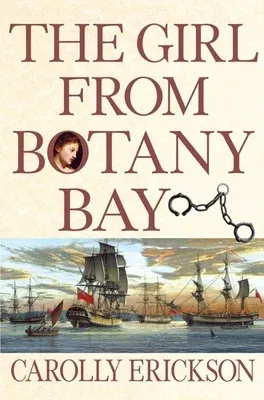On a moonless night in the early 1790s, prisoner Mary Bryant, her
husband William, her two small children, and seven
other convicts stole a twenty-foot longboat and slipped noiselessly out
of Sydney Cove, Australia, eluding their captors.
They sailed north, all the way to Indonesia, traveling some thirty-six
hundred treacherous miles in ten weeks--an incredible feat of
seamanship. For a time, Mary and her companions were able to convince
the local Dutch colonial authorities that they were survivors of a
shipwreck, but eventually the truth emerged and they found themselves
back in captivity, in irons, on their way to England for execution.
In time, Mary's fateful journey would win her tremendous admiration. A
woman once reviled as a criminal would become a London celebrity,
ultimately finding forgiveness and freedom.
In The Girl from Botany Bay, distinguished historian and biographer
Carolly Erickson tells Mary Bryant's remarkable story at full length for
the first time--the story of a woman whose impoverished Cornwall
childhood led to a life of outlaw daring and thievery, then to harsh
imprisonment and exile. Erickson recounts Mary's bold ventures from her
point of view, beginning with her conviction and death sentence for
highway robbery. Reprieved, she was sent to New South Wales to serve out
her time, one of dozens of female convicts chosen as sexual companions
for the hundreds of male convicts destined for settlement in the remote
continent of Australia.
From Mary's perilous sea journey to Botany Bay and Sydney Cove, to the
inhuman conditions at the penal colony, to the risky escape to the
Indonesian island of Timor and the horrors of the sail back to
England--during which Mary's husband and two children died of
disease--the story is harrowing yet heroic. With the dramatic narrative
skill for which she is acclaimed, Erickson brings Mary and her
companions to life in compelling detail. All the dangers of seafaring
adventure are here: violent storms, near drownings, severe hunger and
thirst, and the perils of relentless exposure to sun, wind, and salt
spray that left the convicts with their skin scraped raw and their
strength leached away.
When she finally landed in England and testified before the magistrate's
court, Mary was magnificent in her own defense. No one had the heart to
condemn her; had she not, through her suffering, paid for her crimes?
Impressed by Mary's sturdy self-possession and courage, lawyer and
author James Boswell came to her rescue, ensuring that "the Girl from
Botany Bay," as the newspapers called her, was freed and able to begin a
new life.
The epic story of Mary Bryant, the brave and resourceful girl from
Botany Bay, is compelling narrative nonfiction at its very best.

